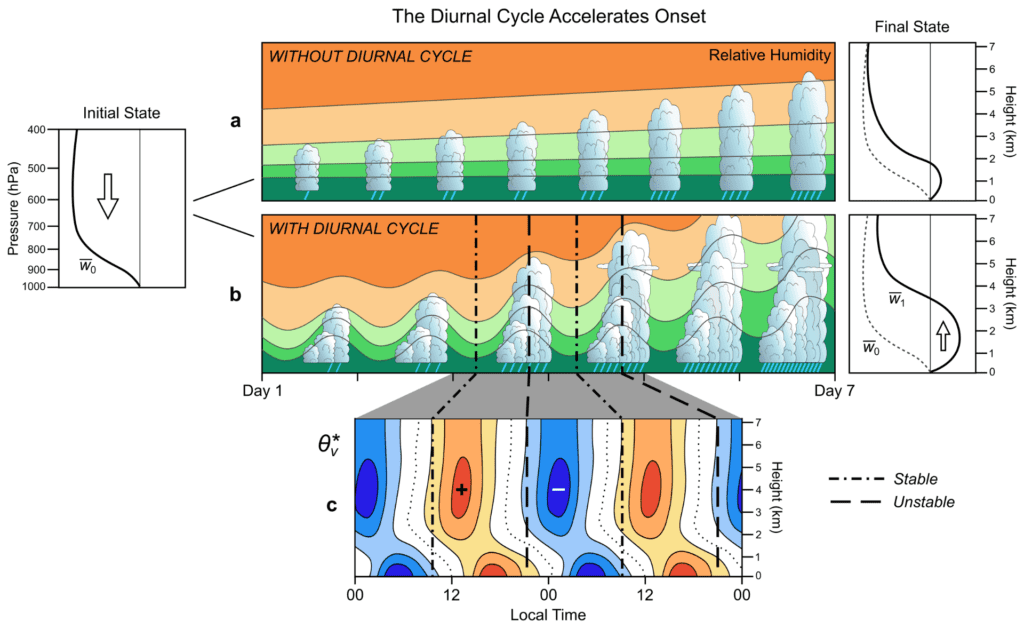See our publication page for the most up-to-date activity from our group.

Influence of mid-level vertical wind shear on supercells
In other recent work, we set out to examine the how vertical wind shear in the middle layer of the troposphere influences supercell thunderstorms, that is, those with persistently rotating updrafts. Unexpectedly, we found that the environmental vorticity associated with midlevel shear has little impact on a supercell. In fact, in most supercells, the vertical rotation characteristic of their updrafts seems to be less important in driving low pressure than horizontal rotation associated with intense vortices occurring at the updraft edges. We refer to these features as “horizontal rotors,” and present evidence that they may be important in updraft dynamics. Future work is actively exploring this possibility.
The journal article corresponding to this work is available here.
Hurricanes and cloud–radiation interaction
The clouds of tropical cyclones strongly interact with both infrared (or longwave) and solar radiation. The interaction with longwave radiation — referred to as the “cloud–greenhouse effect” – accelerates their formation by heating the storm core. In our recent paper, we found that removing this effect either delays or completely prevents intensification in both Super Typhoon Haiyan (2013) and major Hurricane Maria (2017). Our work on this subject was recently highlighted in Science. Our recent talk on this work from the 2021 AMS Annual Meeting is available here.
Additionally, the interactions of the clouds of TCs with solar radiation leads a dramatic diurnal cycle, which manifests in their clouds, rain bands, and transverse circulation. Our recent paper on this subject was featured in an Eos Research Spotlight.
Click here for a recorded presentation on this work.

From Ruppert et al. (2020, PNAS)

The Maritime Continent
An excellent example of scale interaction is the Maritime Continent – the island archipleago that includes Indonesia. We have recently examined how diurnal deep convection here excites long-lived gravity waves of a scale ~1500 km, which diurnally phase lock over multiple islands (Borneo and Sumatra), linking the diurnal burst of convection in one island with that of another on the next day. I am currently investigating mechanisms of climatological island rainfall enhancement in this region through such feedbacks.
Gravity waves and diurnal circulation coupling
Through interactions between clouds and radiation, the diurnal cycle drives pronounced mesoscale circulation changes in organized convective systems. This occurs because of how rapidly gravity waves propagate, which results in a rapid circulation adjustment into balance with changes in latent and diabatic heating. Our research on this subject suggests that this effect causes a diurnal cycle of the Hadley Cell and the ITCZ coupled with it.


Diurnal cycle and time-scale feedbacks
I am greatly fascinated by how clouds and moist convection create links across scales, both in space and time. An excellent example of “time-scale feedback” is the effect that the 24-hr diurnal cycle has on the background weather and climate states in which it operates. We have studied this problem using data from the international DYNAMO field campaign in relation to the Madden–Julian oscillation. Through controlled hypothesis testing using cloud-resolving numerical modeling, we managed to identify how this diurnal time-scale feedback works: namely, the covarying diurnal cycles of humidity and static stability lead to a more rapid transition from shallow to deep convection than without the diurnal cycle.